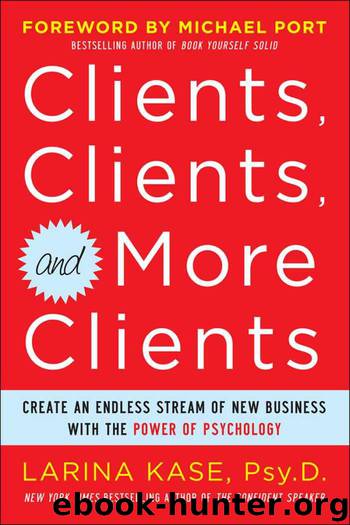Clients, Clients, and More Clients: Create an Endless Stream of New Business with the Power of Psychology by Kase Larina

Author:Kase, Larina [Kase, Larina]
Language: eng
Format: mobi
Publisher: McGraw-Hill
Published: 2011-10-02T16:00:00+00:00
Becoming Fluent and Providing Value
ACTION STEPS
1. Do three 10-minute freewrites. Write quickly and without censor to open up your mind and generate unique and creative content. Write about whatever comes to mind, or use prompts or tools such as the ones previously described. You might not create usable content from these three freewriting sessions alone, but you’ll gain comfort with the process and can use it to move your thinking forward and create content in the future.
2. Break up your articles. Go through some of your longer articles and break them up into two or three parts to extend your keep-in-touch. Remember that less is typically more with e-mail marketing. Receiving a verbose article or e-zine is overwhelming to a lot of people.
3. Post articles on your blog but not in your e-zine. I often do this to keep my e-zine from getting long and intimidating. I include some personal stories, tips, and news in the e-zine and a link to read the article on the blog. Bringing people onto your blog is nice because they can comment there and you can further build your relationships rather than simply deliver one-way communication.
4. Frame outreach marketing on recent results. Often when we receive a piece of marketing from someone, we assume that they’re doing it because they need more business. To counteract this, be in touch with people regularly as we’ve discussed, and include positive results in your marketing. For example, a real estate agent can send out a postcard that says, “In the past three months, I’ve sold these homes in your neighborhood …” This focuses on the use of data and the similarity principle discussed earlier since people share a common situation (neighborhood) with their neighbors.
5. Brainstorm 20 subject lines for each e-mail. We usually start to sound more natural and create more interesting ideas when we stop trying to come up with one and start brainstorming a whole bunch.
6. Look at your message for one second. How do you feel? Be honest. If you feel that it is a lot of work to read all the information, others will feel the same way. Break it up. Include white space, images, and graphics to add visual appeal.
Download
This site does not store any files on its server. We only index and link to content provided by other sites. Please contact the content providers to delete copyright contents if any and email us, we'll remove relevant links or contents immediately.
Nudge - Improving Decisions about Health, Wealth, and Happiness by Thaler Sunstein(7498)
Deep Work by Cal Newport(6840)
Principles: Life and Work by Ray Dalio(6160)
Factfulness: Ten Reasons We're Wrong About the World – and Why Things Are Better Than You Think by Hans Rosling(4650)
The Doodle Revolution by Sunni Brown(4644)
Eat That Frog! by Brian Tracy(4403)
Thinking in Bets by Annie Duke(4132)
Hyperfocus by Chris Bailey(4021)
Visual Intelligence by Amy E. Herman(3704)
Writing Your Dissertation in Fifteen Minutes a Day by Joan Bolker(3655)
How to Win Friends and Influence People in the Digital Age by Dale Carnegie & Associates(3479)
Ogilvy on Advertising by David Ogilvy(3474)
Hidden Persuasion: 33 psychological influence techniques in advertising by Marc Andrews & Matthijs van Leeuwen & Rick van Baaren(3432)
How to win friends and influence people by Dale Carnegie(3369)
The Pixar Touch by David A. Price(3341)
Schaum's Quick Guide to Writing Great Short Stories by Margaret Lucke(3293)
Deep Work: Rules for Focused Success in a Distracted World by Cal Newport(3094)
Work Clean by Dan Charnas(3021)
The Slow Fix: Solve Problems, Work Smarter, and Live Better In a World Addicted to Speed by Carl Honore(2925)
